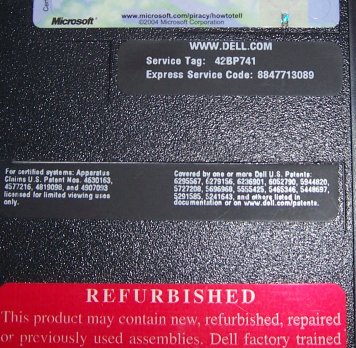The Capacitor Plague
Ok. This is serious. If you've been reading my descriptions of the Dell Optiplex SX-270 machines here on Contra and have considered buying one on the used market, hold off. Something Funny Is Going On Here. I ordered two machines (a beat-up 2.8 GHz unit for $250 and a near-mint 2.6 GHz unit for $375) and they have worked flawlessly. Once I got the peeled-off inventory sticker goop off of them, they even look reasonably good. Pete Albrecht bought a cheaper machine for $150, and it worked for ten minutes and croaked.

When he opened it up (see photo above) he found that several of the electrolytic capacitors on the motherboard were bulging severely upward, and one of them had actually popped the pressure-release scores on its top. It didn't take a lot of research to find out what had happened. Start with the Wikipedia article on the problem. There are two basic unrelated failure modes: Some caps (especially from Nichicon) were overfilled with electrolyte, and popped because there was no room for expansion within the capacitor body. The other problem is that a Taiwanese manufacturer evidently stole a formula for electrolytic capacitor electrolyte, and the stolen formula did not list all the ingredients. The secret anti-corrosion compound was not included in the stolen formula, which caused the caps to be filled with an excessively corrosive electrolyte. This weakened the aluminum cap body and caused it to fail early. Here's another item on the espionage issue.

The caps have been used in a lot of things, including CF lamp bulbs (which I have tried and found to fail in only a month or two...hmmmmm...) but especially computers. The problem is so widespread that there is even on online forum about it, called badcaps.net. Astonishingly, some manufacturers are allegedly continuing to use bad caps in new manufacturing. The only way to avoid the issue completely is to avoid the use of Taiwanese caps entirely; one site suggests the Rubycon brand from Japan. (Home constructors take note here: It's important to test every component before you solder it into a circuit. An electrolytic cap with measured capacitance more than 20% below the marked value should not be used. Pitch it.) Dell acknowledged the issue back in mid-2005, and has supposedly been good about replacing the bad mobos. They have a sort of supplemental warranty for capacitor failure in SX270, GX270 and GX280 models that is good until January 31, 2008, or five years after the date of original puchase (whichever is earlier) which is probably the manufacture date for used machines.
As best we can tell from combing the Web, not every SX270 is prone to the problem. The ones to avoid are older units with service tags that end in 21 and 31. These are generally machines with manufacture dates in 2003 or before. Pete's machine's service tag ends in 31; both of mine end in 41. So I have hopes that mine will stay alive, but I'm watching them closely. The service tag can be found on an adhesive label on the left-hand panel of machines mounted vertically, or on the bottoms of machines mounted horizontally. See the photo above. Thanks to Don Bullard, we found a Dell lookup page that accepts a service tag and tells you when the machine was built. This will help you take advantage of the Dell capacitor warranty if it fails.